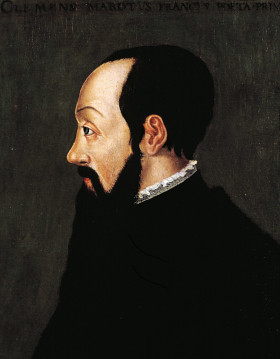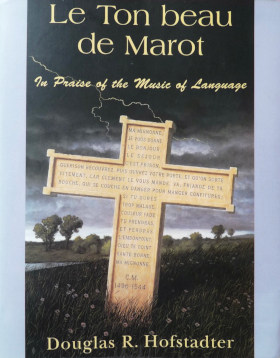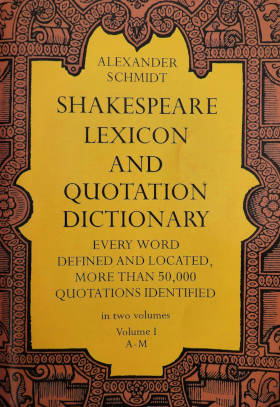In 1537, Jeanne d’Albret de Navarre, aged eight, fell ill and had to stay in bed, possibly in some form of quarantine. We know this because one of the most celebrated poets of the French Renaissance, Clément Marot, wrote her a get well soon note in verse. It’s a short poem, and at first glance even a rather simple one. But its compact size also makes it a definite challenge to translate. And nearly 500 years later, it still has the power to resonate with our experience of the modern world.
Marot first joined the court of Jeanne’s mother, Marguerite of Navarre, sometime around 1519. He was there until 1527, when he became a valet de chambre to Marguerite’s brother, the King of France, François I. But Marot remained in close contact with Marguerite and her family until he was forced into exile near the end of his life in 1542. When young Jeanne fell ill, it seems only natural that the poet wanted to wish her well. It’s also probable that doing so wouldn’t have hurt his prospects for future employment.
Despite containing a few archaisms, the poem that Marot wrote to poor Jeanne is surprisingly clear to readers of modern French. It’s made up of 14 rhyming couplets, whose lines are just three syllables long. This helps make the poem feel a bit like a nursery rhyme, perhaps fitting given its intended recipient. The first line of the poem is also repeated as the last line, ensuring that the opening and closing couplets share the same rhyme. Here it is in Marot’s French:

A une Damoyselle malade
Ma mignonne,
Je vous donne
Le bon jour ;
Le sejour
C’est prison.
Guerison
Recouvrez,
Puis ouvrez
Vostre porte
Et qu’on sorte
Vistement,
Car Clement
Le vous mande.
Va, friande
De ta bouche,
Qui se couche
En danger
Pour manger
Confitures ;
Si tu dures
Trop malade,
Couleur fade
Tu prendras,
Et perdras
L’embonpoint.
Dieu te doint
Santé bonne,
Ma mignonne.
What initially reads like a simple poem written hastily for a child turns out to have some fairly tight formal constraints. Ignoring the first and last lines, all of the poem’s units of sense are also out of step with the rhyming couplets. This means that each unit of sense spans two different rhyming couplets. These semantic units are almost all separated in the poem by punctuation marks, but on one occasion they are separated by a conjunction.
Curiously, in the first half of the poem, Marot addresses Jeanne using the formal personal pronoun, vous, while in the second half he switches to the informal pronoun, tu. Why he did this, we don’t know. As a princess, Jeanne was easily Marot’s social ‘superior’ and could normally expect to be addressed using the formal vous. But he was clearly on friendly terms with a girl who was much younger than himself, which would have made the use of the informal tu more likely. Aside from being a neat formal trick, changing pronouns might simply have made certain lines easier to write. In many cases, using the formal vous in French adds an extra syllable to the verb being conjugated.

I first became aware of Marot’s poem a few years ago, when I chanced upon a copy of Le Ton Beau de Marot: In Praise of the Music of Language by Douglas R. Hofstadter. At its heart, the book is a wide-ranging inquiry into the nature of language and the art of translation. In it, Hofstadter asks some big questions: about the mental processes involved in language creation, whether translation can truly be a successful process, about when a translation becomes a new work in its own right, and whether machine learning can ever use language as well as a human being. He mixes this with autobiography, analysis, and plenty of wordplay. Published in 1997, much of the book now feels remarkably prescient in an age of Google Translate and ChatGPT.
Running through the book like a unifying thread is Marot’s poem, which Hofstadter uses to illustrate some of the many linguistic and translation problems he discusses. To do this, he presents the original poem in French along with 88 different translations into English. Many of these were made by himself. But others were made by colleagues, students, poets, professional translators, and even machine translation programs like Systran and Candide, the immediate predecessors of Google Translate. As might be expected, the results are wildly diverse. But Hofstadter also challenges readers of the book to produce their own translation of the poem to experience firsthand the things he is talking about. Naturally, it was a challenge I accepted.
I was firstly keen to preserve as many of the poem’s formal elements as possible, starting with the rhyming couplets and their short three syllable length. While stress is less of a feature in French poetry than it is in English, the main stress in every line of the original could be said to fall on the third syllable. Most of the lines also have some degree of secondary stress on the first syllable. To try and emulate this in English, the stress pattern for those three syllables really has to be stressed-unstressed-stressed, often notated in systems of scansion as / x /.
Something that a lot of the translations in Hofstadter’s book don’t address is the historical nature of the poem in French, written nearly 500 years ago. Many of them actually try to modernize the poem’s language, inadvertently transposing the setting to some sort of near past as a result. And, at least according to Hofstadter, that’s a valid strategy for translating the poem. However, I wanted to try and preserve something of the effect that Marot’s poem has on a modern French reader. To do this requires translating it into an English that at least might have been spoken in the 16th century.
I took as my model the English of William Shakespeare. While he wrote slightly later than Marot, there are plenty of resources available that document the language he used. One of the best is the Shakespeare Lexicon and Quotation Dictionary by the German philologist, Alexander Schmidt, first published in 1875. This is a mine of information, that gives definitions of words as used by Shakespeare, examples of usage, and references to where in his work specific words are used. There is a free version available online, but I have a two-volume edition published by Dover.
Using a version of English that is historical would certainly let me address the problem posed by Marot’s use of both the vous and tu pronouns. In modern English, both of these would be translated by the pronoun ‘you’. But English in Shakespeare’s time still preserved this difference with two pronouns, the formal ‘you’ and informal ‘thou’. It would also obviously make it easier to try and reproduce some of the slightly archaic language present in Marot’s poem.

After spending a good deal more time than I initially expected, here is the translation I settled on along with Marot’s original:
A une Damoyselle malade
Ma mignonne,
Je vous donne
Le bon jour ;
Le sejour
C’est prison.
Guerison
Recouvrez,
Puis ouvrez
Vostre porte,
Et qu’on sorte
Vistement,
Car Clement
Le vous mande.
Va, friande
De ta bouche,
Qui se couche
En danger
Pour manger
Confitures ;
Si tu dures
Trop malade,
Couleur fade
Tu prendras,
Et perdras
L’embonpoint.
Dieu te doint
Santé bonne,
Ma mignonne.
To a Sick Damsel
My fair sweet,
I do greet
You this day;
Forced to stay
In this gaol,
Cease to ail
And be sound,
Then do bound
To your door,
Quickly for
To skip free,
Clement, he
Asks you this.
Thou whose bliss
Is to taste,
Yet who waste
Sick abed,
Come be fed
On quince pie;
If thou lie
Too long ill
Fade thou will
Unto white
And from right
Plump will pine.
God make thine
Health complete,
My fair sweet.
Some parts of the poem clearly present more of a challenge to translate than others. Because the first and last couplets share the same rhyme, for example, that rhyme needs to work for three different lines rather than two. I solved this problem in the second to last line with the adjective ‘complete’, which in Shakespeare’s time could still mean ‘perfect’.
There’s a certain degree of repetition contained in Lines 6 and 7 of the poem:
Guerison
Recouvrez,
The idea here is that Jeanne should recover her good health. I’ve tried to mimic this by using both a negative equivalent and a positive adjective:
Cease to ail
And be sound,
One of several meanings that the adjective ‘sound’ had in the 16th century was ‘healthy’. This is the meaning preserved in the modern English saying ‘safe and sound’.
The only place in my translation where the semantic content of the original is reversed comes in Lines 10 and 11:
Et qu’on sorte
Vistement,
becoming:
Quickly for
To skip free,
I’ve done this firstly because to my ear it sounds more natural in English, even if it means that the adverb now refers to the verb ‘bound’ in line 8. It also lets me use the ‘for to’ construction followed by an infinitive, used reasonably often by Shakespeare with a meaning of ‘in order to’.
I think my biggest departure from the original comes in Line 19, where Marot urges Jeanne to eat confitures. Here I couldn’t make any direct equivalent work. The typical modern translation, ‘jam’ only came into English in the 18thcentury. ‘Marmalade’ was known in Shakespeare’s time, but I couldn’t find an appropriate rhyme to complete the couplet. Its pronunciation would also have to be wrenched to stress the final syllable. I reasoned that Marot was probably more interested in a word that would rhyme with the next line than with what type of comfort food Jeanne should be eating. I take as my authority for ‘quince pie’ a short line in Romeo and Juliet:
NURSE. They call for dates and quinces in the pastry.
The ‘pastry’ here being the room in which pies and pastries were made rather than the dish itself.
With an almost total absence of metaphor or figurative language, the real difficulty in translating Marot’s poem lies in its formal characteristics. The poem’s very short rhyming couplets, for example, leave little room for manoeuvre. As a result, there’s almost nowhere that you can avoid translating all of the sense in one line, knowing that you can express it elsewhere. And because the semantic content of the poem is out of step with the rhyming couplets, you feel strangely like you’re always taking two steps forward and one step back. Possibly my only regret was not being able to reproduce Marot’s use of just one word for three of the poem’s lines. This was a touch of poetic bravado that multi-syllable words in English seemed unwilling to follow.
I’m a compulsive buyer of books. So when I first came across Hofstadter’s book, I bought it and simply put it on one of several piles to be read at some time in the future. It wasn’t until the world was in the midst of a pandemic and successive lockdowns that I finally picked it up to read it. I was already a good way through when it occurred to me that, in the poem’s short telegram-style lines addressed to someone who was ill, possibly in quarantine, Marot might easily be texting a friend who was self-isolating with COVID; just checking in, wishing them all the best, hoping to see them again soon. Sometimes we’re not so removed from the past as we think.
